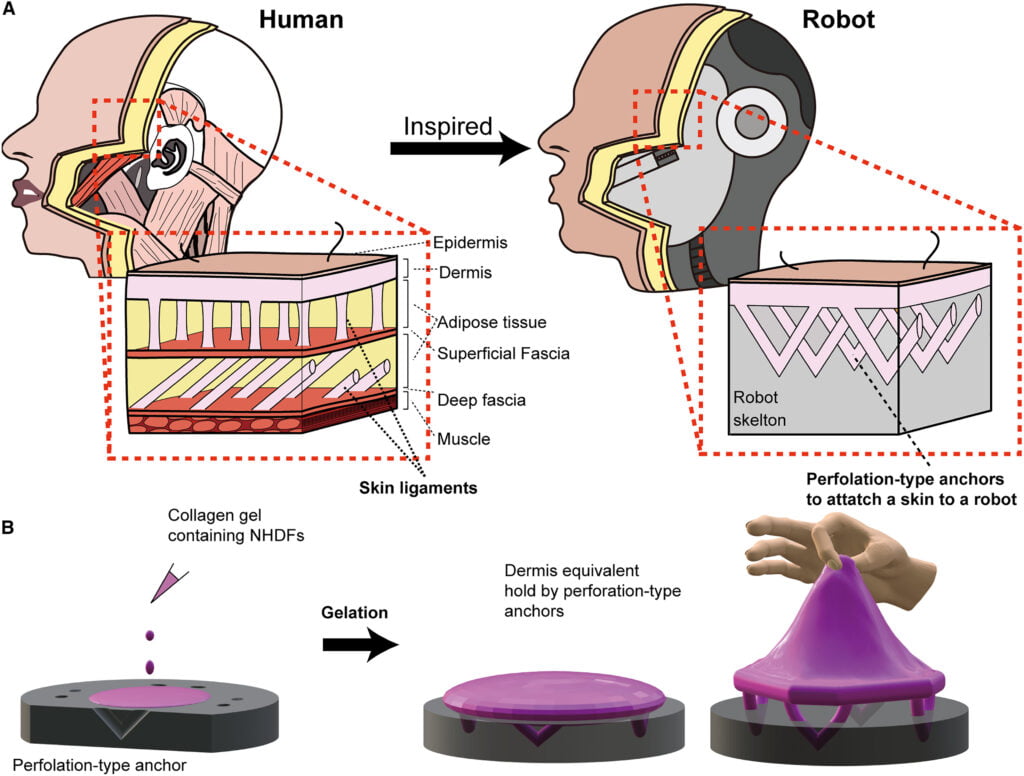A breakthrough has been achieved by researchers who found a way to bind engineered skin tissue to the complex forms of humanoid robots. The team, led by Professor Shoji Takeuchi of the University of Tokyo, integrated special perforations into a robot face, which helped a layer of skin to adhere successfully. This research will benefit the cosmetics industry and plastic surgeons.
This research was inspired by the structure of human skin ligaments and utilized technology that bonds biological tissues and artificial materials to create the face-shaped robot. The technology developed for creating robots with cultured skin is expected to be used in the development and application of humanoid robots with biological functions, as well as in understanding the mechanisms of wrinkle formation in the fields of cosmetic and plastic surgery medicine.
According to the research team, previous humanoid robots and other robots have been covered with silicone rubber to simulate human-like soft skin. While silicone rubber is soft, it lacks the self-healing, sensory, and sweating capabilities of biological tissues.
Under the guidance of Takeuchi, a pioneer in the field of biohybrid robotics, biology and mechanical engineering have converged. The Biohybrid Systems Laboratory has already created mini robots that walk using biological muscle tissue. Takeuchi felt the need to further develop the idea of robot skin to enhance its properties and capabilities.

The research team led by Takeuchi developed a ‘hole-shaped anchor structure’ by gelling skin tissue inside V-shaped perforations in the artificial material, and used this to create a face-shaped structure covered with living cultured skin. They also developed a face-shaped robot that smiles by demonstrating a method of transmitting power to the skin tissue of the anchor structure, where the power from the motor is transferred to the skin through the hole-shaped anchor.
Similar POSTS
Takeuchi explained, “By mimicking human skin-ligament structures and by using specially made V-shaped perforations in solid materials, we found a way to bind skin to complex structures. The natural flexibility of the skin and the strong method of adhesion mean the skin can move with the mechanical components of the robot without tearing or peeling away.”
The team used a special collagen gel for adhesion and managed to coax the collagen into the fine structures of the perforations. Takeuchi added, “Manipulating soft, wet biological tissues during the development process is much harder than people outside the field might think. For instance, if sterility is not maintained, bacteria can enter and the tissue will die.”

Takeuchi and his lab have a goal in mind for this application that could help in several areas of medical research. According to Takeuchi, in this study, they managed to replicate human appearance to some extent by creating a face with the same surface material and structure as humans.
The research team anticipates that more testing will be needed over the next several years before this technology can be applied to everyday life. They expect that this research could assist doctors in clinical trials in areas such as skin aging, cosmetic surgery, and aesthetics. Professor Takeuchi noted, “Additionally, through this research, we identified new challenges, such as the necessity for surface wrinkles and a thicker epidermis to achieve a more humanlike appearance. We believe that creating a thicker and more realistic skin can be achieved by incorporating sweat glands, sebaceous glands, pores, blood vessels, fat and nerves. Of course, movement is also a crucial factor, not just the material, so another important challenge is creating humanlike expressions by integrating sophisticated actuators, or muscles, inside the robot. Creating robots that can heal themselves, sense their environment more accurately and perform tasks with humanlike dexterity is incredibly motivating.”
Realistic facial expressions enhance the robot’s ability to communicate and interact more naturally and effectively with humans, which is particularly important in the medical field where empathy and emotional connection can impact patient care.






